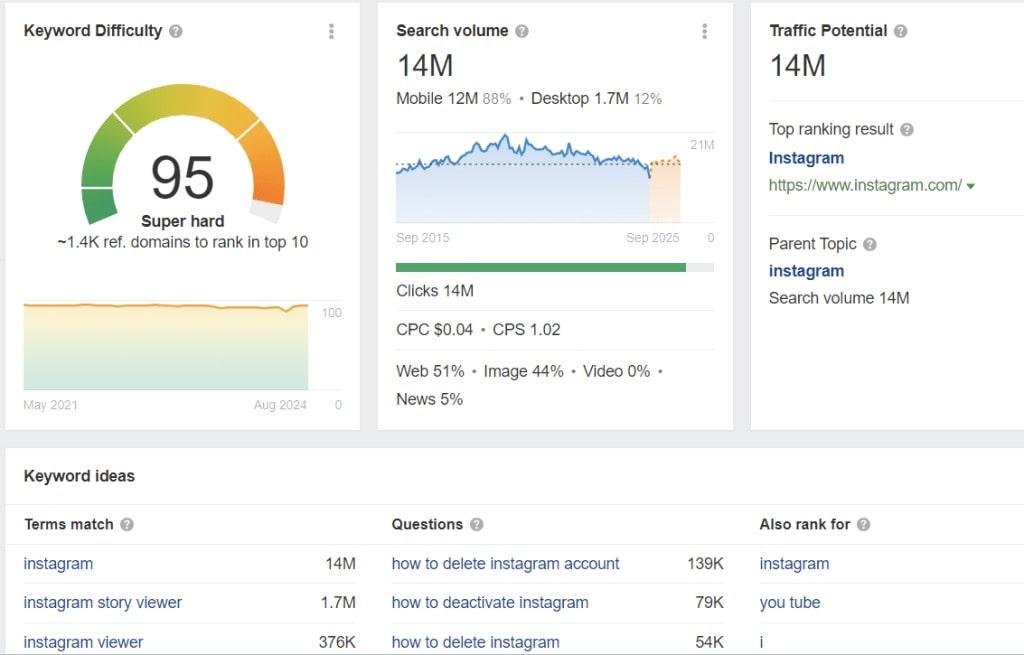How do you know if people recognize your brand or remember it at the right moment? That’s where brand awareness metrics come in.
These metrics help you measure how well your brand is known, what people think about it, and whether they recall it when making a purchase.
Without tracking them, you’re just guessing. Are people talking about your brand? Do they recognize your logo? Are they searching for you online?
By understanding and tracking the right brand awareness KPI, you can ensure your brand stays top-of-mind. Let’s dive into the key metrics you need to watch.
Disclaimer: If you buy any products through links on this site, I may earn a commission. But it doesn't make any difference to your cost, and it helps me keep this blog running. So you could always read my articles for free.
How to measure brand awareness
If you want to measure brand awareness, you need the right setup from the start. First, define what you want to measure. Are you tracking overall recognition, social media buzz, or website searches?
A fashion startup might focus on Instagram mentions, while a B2B SaaS company may track branded Google searches.
Next, set up surveys and feedback forms. Tools like Google Forms, Typeform, or SurveyMonkey help you create brand recall surveys.
Ask new customers how they heard about you or whether they recognize your logo. You can also add pop-up surveys on your website or send email follow-ups post-purchase.
Use Google Analytics and search tools to track branded search volume and direct traffic.
Google Search Console shows how many people search for your brand name, while Ahrefs or Semrush help measure search trends over time.
Social listening is another key step. Install tools like Brandwatch, Sprout Social, or Mention to track brand mentions across platforms, including hashtags and common misspellings. Setting up Google Alerts for your brand name can also help you stay updated.
Finally, benchmark your data and automate reporting. Establish a baseline for key metrics and track progress over time. Google Data Studio or HubSpot dashboards can help you visualize trends and make data-driven decisions.
With the right setup, you can measure brand awareness metrics effectively and refine your marketing strategy based on real insights.
Why monitor brand awareness KPIs
Monitoring brand awareness KPIs helps you understand how well your brand is resonating with your audience. If you don’t track these metrics, you’re making marketing decisions in the dark.
One key reason to monitor brand awareness is to measure the impact of your promotional activities. Let’s say you invest $10,000 in a TikTok ad campaign.
If your brand mentions on Twitter and Instagram increase by 40% within a month, you know your campaign is working. Without tracking, you’d have no way to connect the dots.
Another reason is to stay competitive. Tracking branded search volume, share of voice, and social mentions helps you see how you stack up against others in your industry.
KPIs also help you identify brand perception shifts. If your brand sentiment score suddenly drops on a tool like Brandwatch, it could mean bad press or negative customer experiences.
Big brands like Tesla and Nike constantly monitor online conversations to catch and respond to trends before they escalate.
Finally, tracking brand awareness metrics helps justify marketing budgets. If your CEO questions why you need more ad spend, showing a 50% increase in direct traffic after a campaign can help make your case.
The more you measure, the more you can refine your strategy and grow your brand effectively.
What are the best brand awareness metrics?
Tracking brand awareness helps you understand how well your brand is recognized and remembered by your audience. Here are the key metrics to measure and practical ways to track each.
Branded search volume
Branded search volume refers to how often people search for your brand name or similar terms on search engines like Google.
If more people are searching for your brand over time, it’s a good sign that awareness is growing. For example, “Instagram” sees over 14 million monthly searches, showing strong brand recognition in the social networking space.

How to measure it: Use Google Search Console to track branded keywords and impressions. Go to the “Performance” tab, filter by search queries, and look for terms like your brand name, product names, or common misspellings.
Ahrefs and Semrush also provide branded search volume trends. If you notice a spike after a marketing campaign, it means people are paying attention.
Social media mentions
Social media mentions track how frequently your brand name appears in conversations, hashtags, or tags on platforms like Twitter, Instagram, LinkedIn, and TikTok.
High mentions indicate strong awareness, but the sentiment matters too. A brand like Wendy’s, known for its witty Twitter presence, gets thousands of daily mentions, keeping it top of mind.
How to measure it: Use tools like Brandwatch, Mention, or Sprout Social to track brand awareness metrics like direct mentions, hashtag use, and sentiment analysis.
Set up Google Alerts for your brand name to monitor discussions outside social platforms. If you see an increase in mentions after launching a campaign or partnering with influencers, your efforts are working.
Share of voice
Share of voice (SOV) measures your brand’s visibility in the market compared to competitors. It looks at how much of the conversation is about your brand versus others in your industry.
For example, in the electric car market, Tesla dominates with an estimated 70% share of voice in online discussions, while smaller brands like Rivian or Lucid Motors have a fraction of that.
How to measure it: Use Semrush or Meltwater to compare your brand’s mentions, media coverage, or keyword rankings against competitors.
In social media monitoring tools, look at the percentage of conversations your brand owns within a certain topic or industry. If your SOV is growing, your brand is becoming more recognized.
Direct traffic
Direct traffic measures how many users land on your website by entering your URL directly into their browser instead of finding you through search engines or referrals.
A high direct traffic number suggests strong brand recall—people remember your brand well enough to visit without needing to search for it.
How to measure it: Google Analytics is the best tool for tracking a brand awareness KPI like direct traffic. In GA4, go to “Acquisition” > “Traffic acquisition” and filter for “Direct.”

Compare month-over-month trends to see if your marketing efforts are improving brand recall. For example, after launching a podcast sponsorship, a fintech startup I worked with saw a 25% increase in direct traffic in just three months.
Earned media mentions
Earned media includes articles, blogs, and news coverage where your brand is mentioned organically.
If your brand frequently appears in industry publications or gets referenced by influencers without sponsorships, it’s a strong indicator of growing awareness.
When Airbnb gained traction in its early years, much of it came from press coverage in outlets like The New York Times and Wired.
How to measure it: Use tools like Meltwater or Google News to track brand mentions in online articles and blogs.
Set up Google Alerts for your brand name and track how often you’re featured. If you notice more media mentions after a PR campaign, it means your visibility is increasing.
Brand recall surveys
Brand recall surveys measure how easily people remember your brand when asked about a specific category.
For example, if someone is asked to name a sneaker brand and they say “Nike” without being prompted, that’s strong brand recall. Companies like Apple frequently conduct brand recall research to ensure they stay top of mind among consumers.
How to measure it: Use Google Forms, Typeform, or SurveyMonkey to create surveys asking customers if they recognize or recall your brand. You can run surveys on social media or send them via email.
If 70% of respondents recall your brand unprompted, it indicates strong awareness. Compare results before and after marketing campaigns to measure impact.
Impressions and reach
When running a brand awareness campaign, impressions refer to the total number of times your content is displayed, while reach represents the number of unique users who see it.
A high number of impressions with a lower reach may mean the same people are seeing your content multiple times, which isn’t always bad—it reinforces brand recall.
For example, Coca-Cola’s social media campaigns generate millions of impressions, keeping the brand top of mind.
How to measure it: Social media platforms like Instagram, LinkedIn, and Facebook provide impression and reach data in their analytics dashboards.
In Google Ads and Meta Ads Manager, track these brand awareness metrics for paid campaigns. If your reach is expanding over time, your brand is being seen by new audiences.
Customer referral rate
The customer referral rate measures how many of your existing customers recommend your brand to others. High referral rates indicate strong word-of-mouth awareness.
Dropbox grew rapidly in its early days through its referral program, where users earned extra storage for inviting friends.
How to measure it: If you have a referral program, platforms like ReferralCandy or Post Affiliate Pro track referral rates.
You can also calculate it manually: (Number of referred purchases ÷ Total purchases) × 100. If 25% of your customers come from referrals, it’s a strong sign that awareness is spreading through word-of-mouth.
Brand sentiment analysis
Brand sentiment analysis goes beyond mentions and searches—it looks at the tone of conversations surrounding your brand. Are people speaking positively, negatively, or neutrally about you?
A high number of mentions is great, but if most are complaints, it signals a potential brand perception issue. For example, Tesla’s social mentions often spike after a new product launch, but sentiment varies depending on customer reactions.
How to measure it: Use tools like Brandwatch, Sprout Social, or Mention to track brand awareness KPIs like sentiment analysis. They categorize mentions as positive, neutral, or negative.

You can also monitor customer reviews on sites like Trustpilot and Yelp to gauge sentiment. A shift from neutral to positive sentiment indicates improving brand perception.
Net Promoter Score (NPS)
NPS gives you a sense of customer loyalty by asking one simple question: “On a scale of 0 to 10, how likely are you to recommend our brand to a friend?”
Those who give you a score of 9 or 10 are “Promoters,” 7-8 are “Passives,” and 0-6 are “Detractors.” A higher NPS suggests strong brand awareness and advocacy. Apple consistently scores above 70, reflecting its loyal customer base.
How to measure it: Use tools like Delighted, SurveyMonkey, or Google Forms to send NPS surveys.
Calculate the score as: (Percentage of Promoters – Percentage of Detractors). If your score improves over time, your brand awareness and loyalty are growing.
Backlink profile
A strong backlink profile indicates that people recognize your brand enough to mention it in blogs, news articles, and other websites.
More backlinks from authoritative sites improve SEO and signal brand awareness growth. For example, HubSpot has millions of backlinks because it’s a widely recognized marketing authority.
How to measure it: Use Ahrefs, Moz, or Semrush to track brand awareness metrics like number of backlinks to your site.
Monitor the quality of referring domains—mentions from Forbes or TechCrunch carry more weight than random blogs. If backlinks increase after a PR campaign or guest post, your brand visibility is improving.
Podcast and video mentions
With the rise of podcasts and video platforms like YouTube, brand mentions in these formats are a valuable awareness indicator.
If industry influencers or content creators mention your brand in discussions, reviews, or interviews, it means you’re gaining traction.
Brands like Squarespace and NordVPN have built massive awareness through frequent sponsorship mentions in YouTube videos and podcasts.
How to measure it: Use tools like Podchaser and Listen Notes to search for your brand in podcasts.
YouTube’s search function lets you check if creators are mentioning you in videos. If your brand is appearing in more organic conversations over time, it’s a sign of growing awareness.
Final thoughts on brand awareness metrics
Measuring brand awareness helps you see if your marketing efforts are working. Without data, you’re just guessing. I’ve seen startups assume people know them—until they check metrics and realize they’re invisible.
Tracking brand awareness metrics like search volume, social mentions, and direct traffic gives you real insights. Share of voice helps you see where you stand against competitors. Sentiment analysis shows if people talk about you positively or negatively.
Even referrals and NPS scores reveal how memorable your brand is. Set a baseline, track changes, and adjust your strategy.
Brand awareness isn’t built overnight, but consistent measurement of brand awareness KPIs helps you grow. The more you track, the smarter your marketing decisions will be.
Did I miss anything? Did you try these tips? Do you have any questions or comments? Share your thoughts below in the comments section.





